Solution for Cryptographic Intervention in PCI-Express Data Transmission on FPGA Board
Với đường truyền dữ liệu tốc độ cao
như PCI-Express, việc can thiệp mật mã vào trong
đường truyền để không ảnh hưởng đến quá trình
truyền dữ liệu mà vẫn đảm bảo được tốc độ truyền
dữ liệu của giao thức mang lại sẽ là cơ sở để phát
triển các ứng dụng mật mã sử dụng giao thức PCIExpress.
Trong bài báo này sẽ trình bày một giải
pháp kỹ thuật bắt gói tin dữ liệu của giao thức
PCI-Express sử dụng công nghệ FPGA. Sử dụng
bộ thư viện chuẩn PCI-Express trên máy tính để
thực hiện kết nối tới bo mạch FPGA, qua đó trên
FPGA thực hiện tổ chức dữ liệu theo chuẩn giao
thức PCI-Express, đồng thời tổ chức can thiệp mật
mã trên đường truyền. Như vậy, dữ liệu rõ sẽ được
truyền từ máy tính xuống bo mạch FPGA thông
qua giao tiếp PCI-Express, sau đó được tổ chức,
can thiệp mật mã và truyền lại cho máy tính.
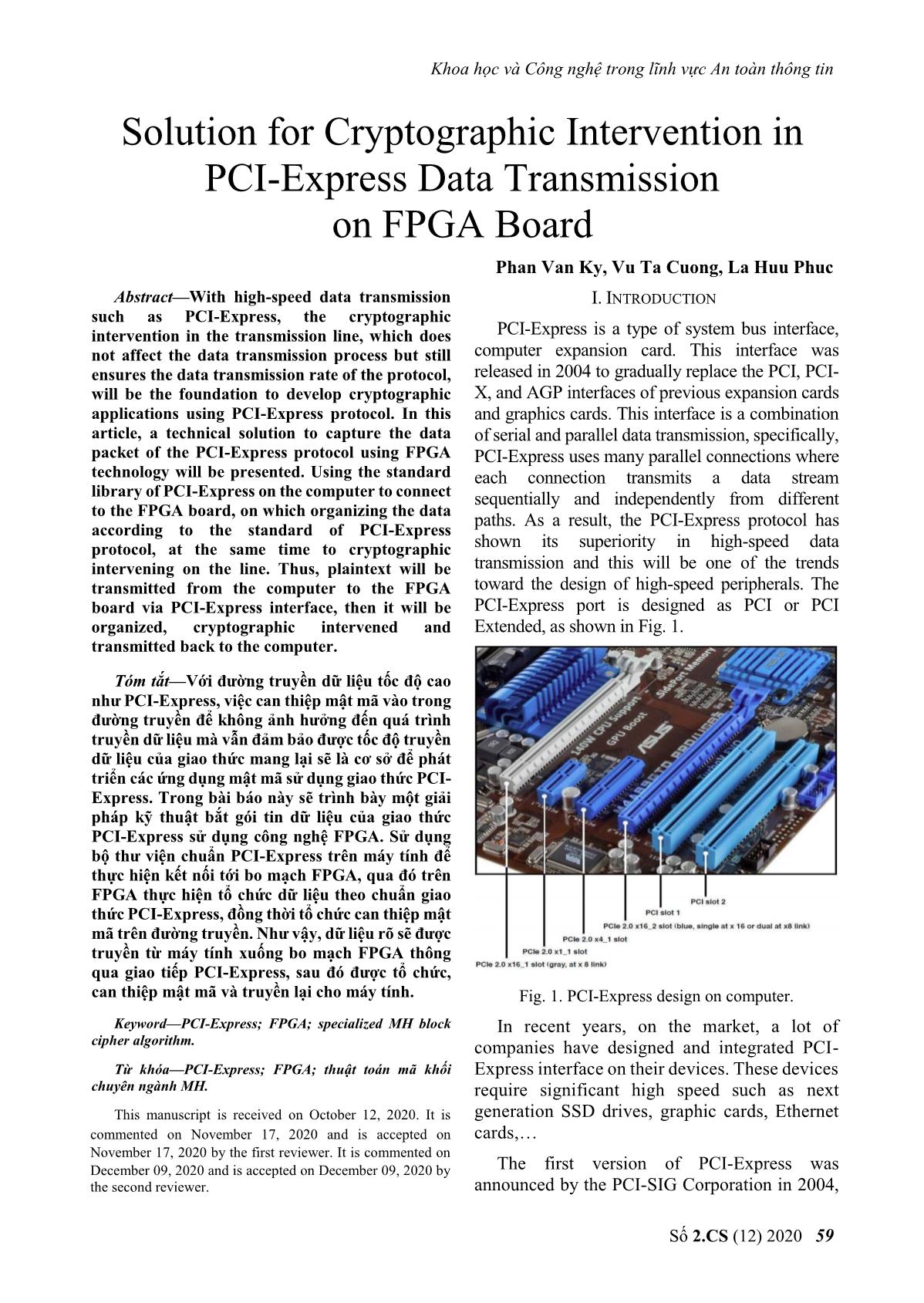
Trang 1
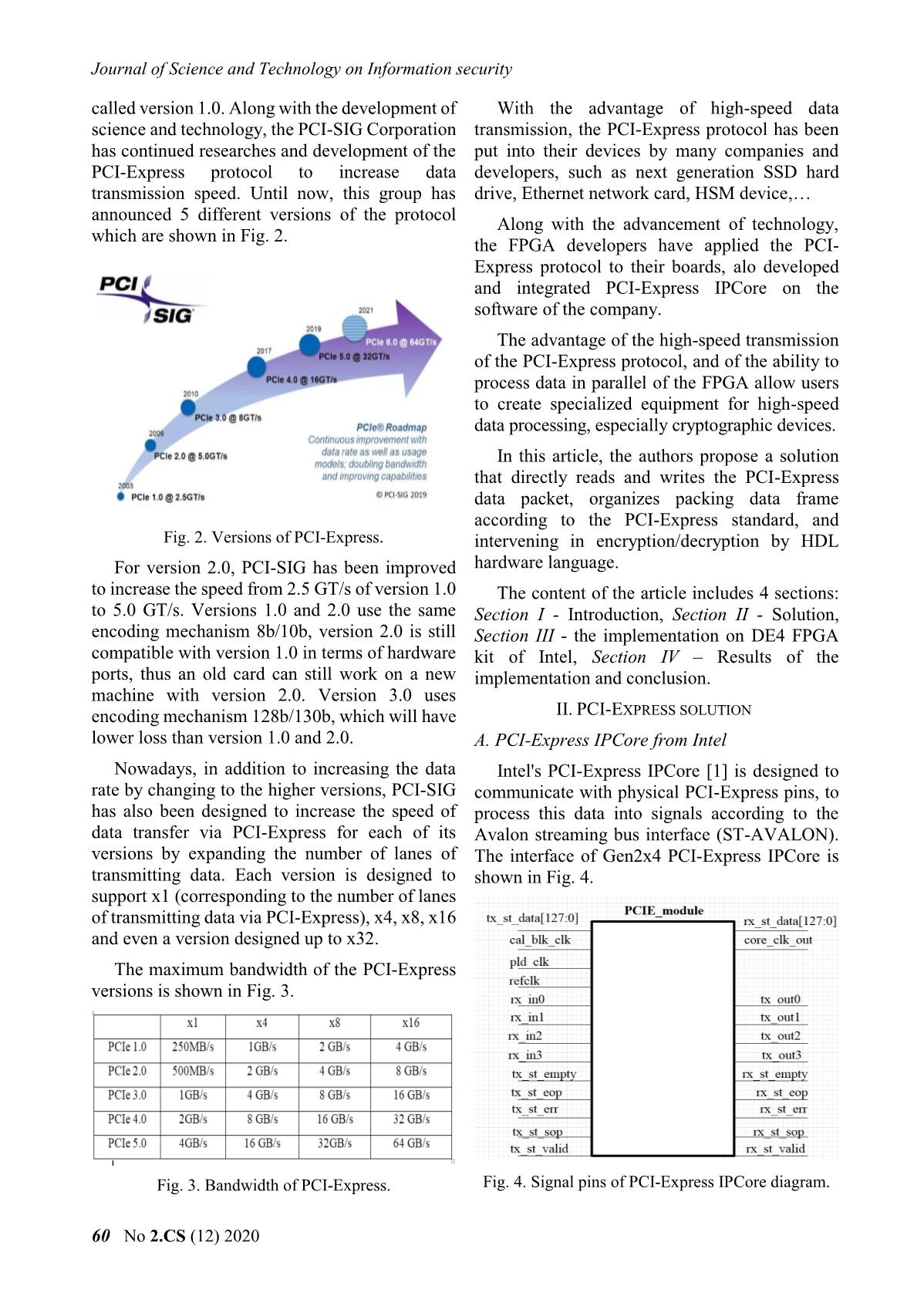
Trang 2
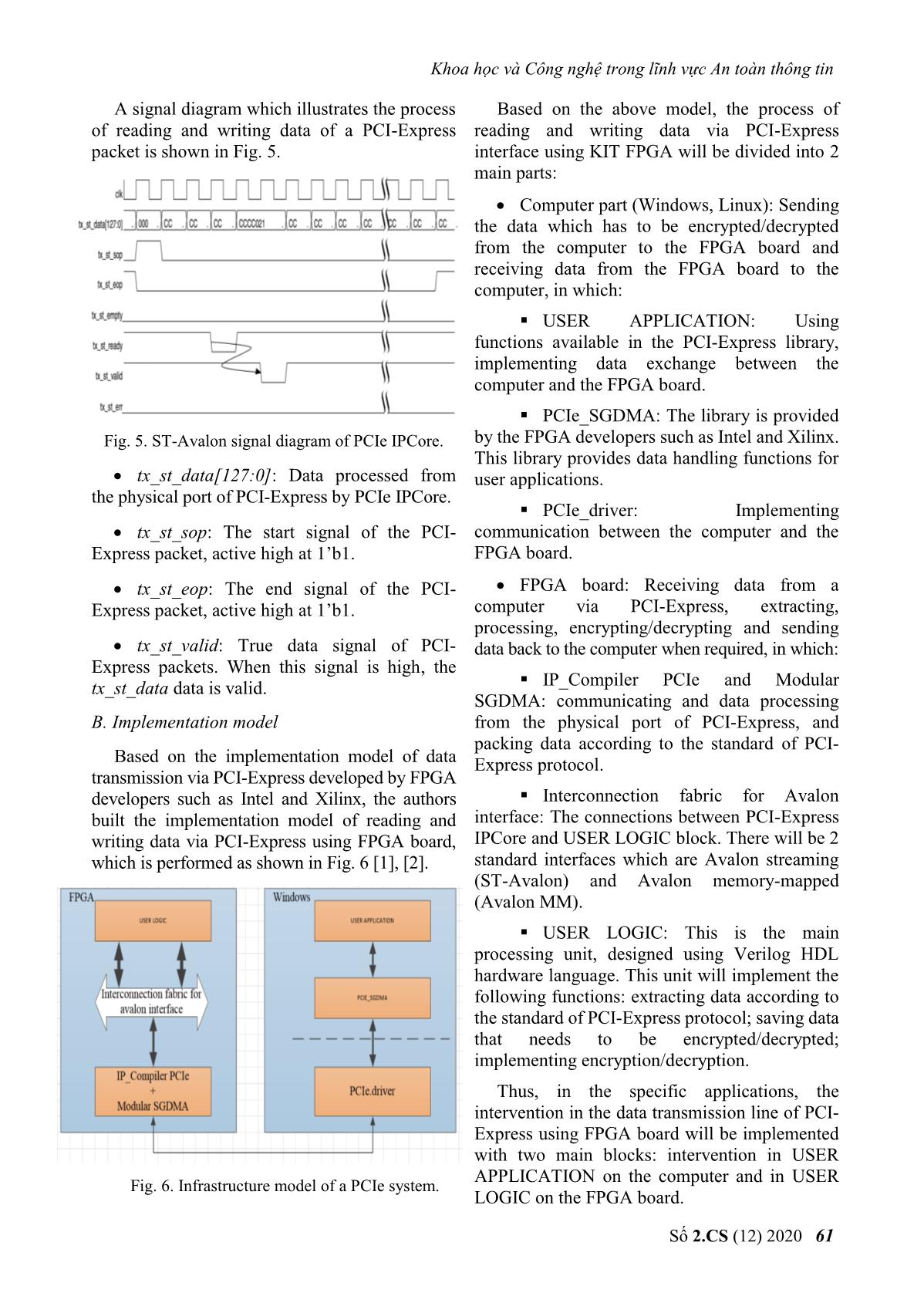
Trang 3
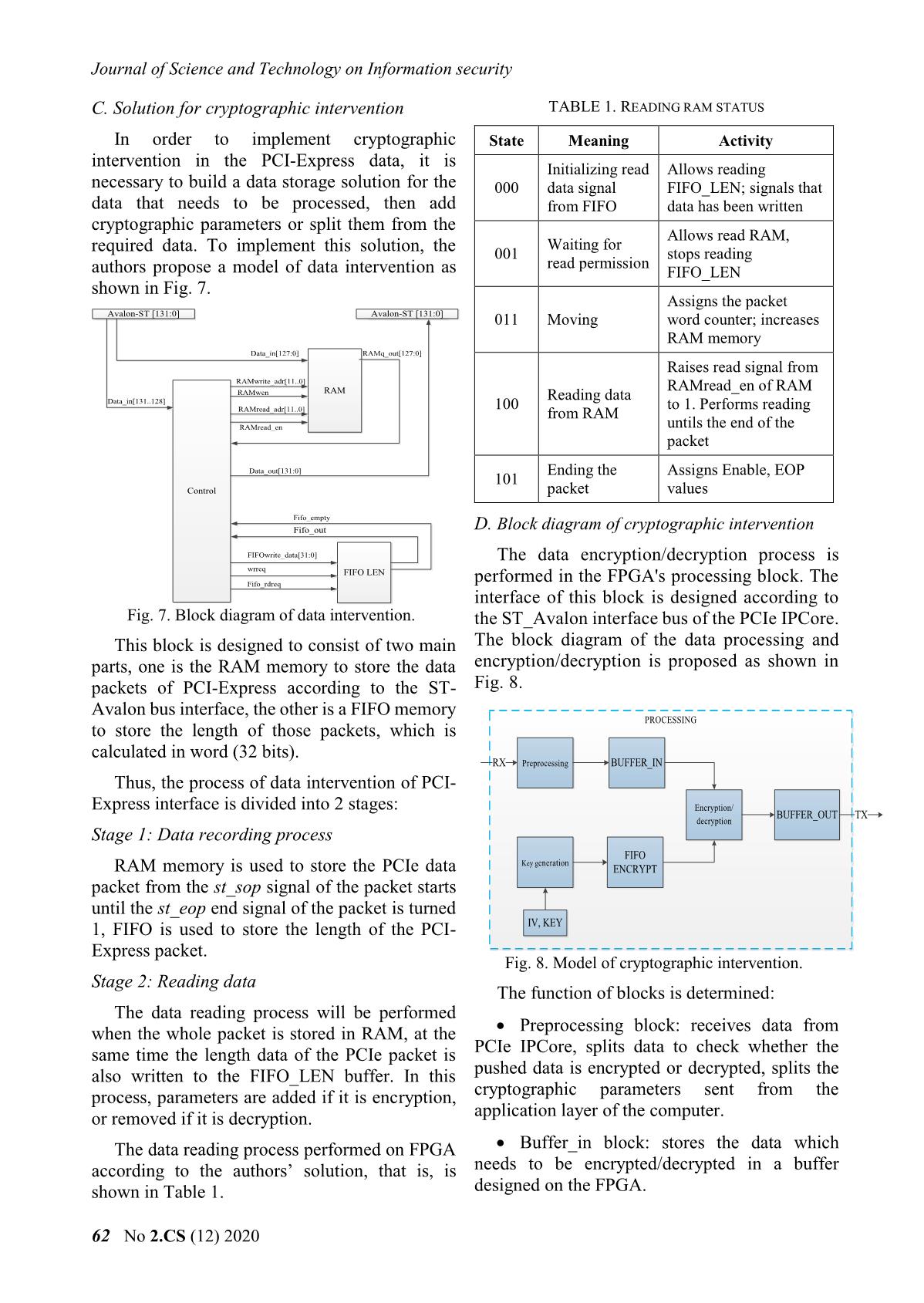
Trang 4
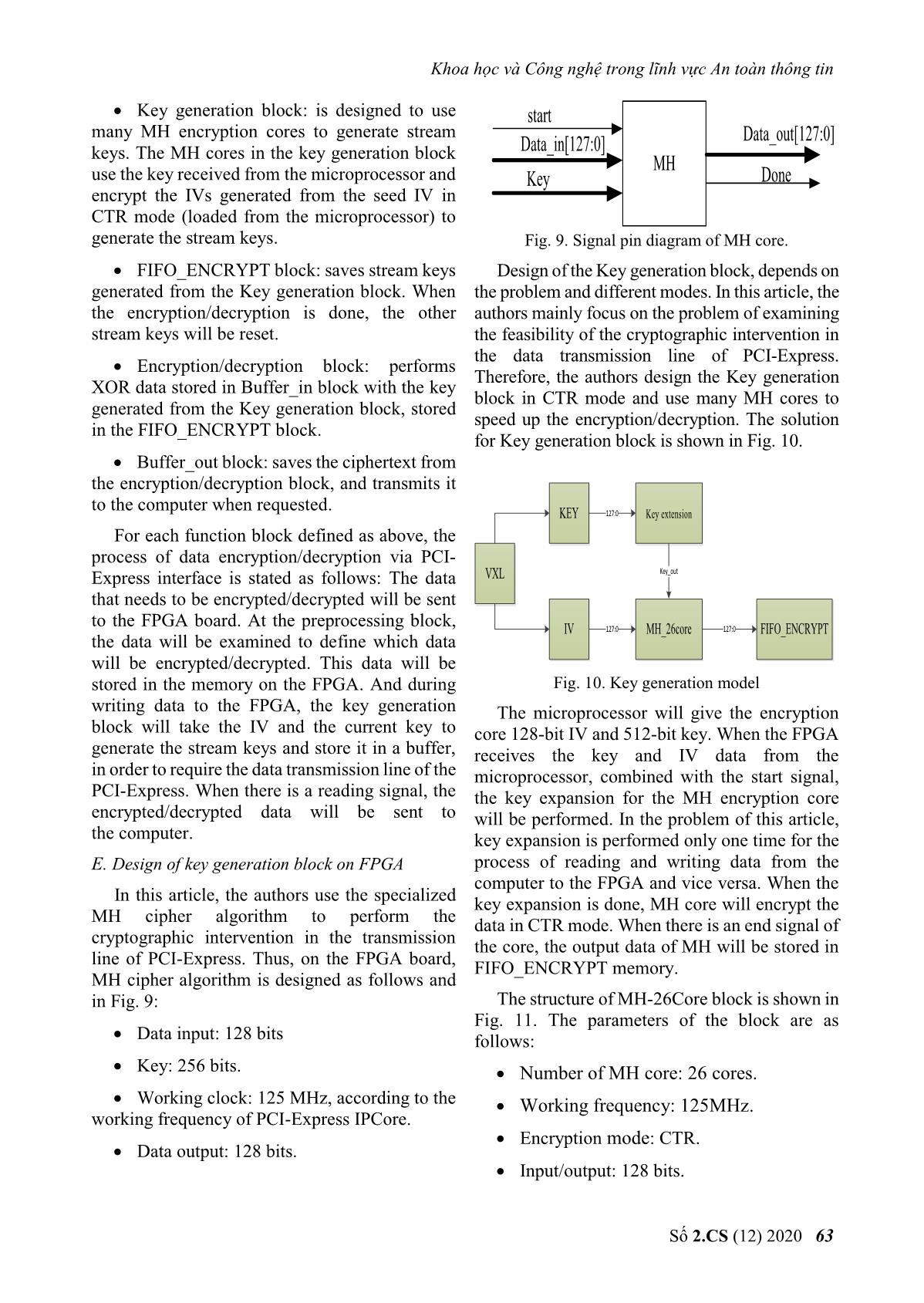
Trang 5
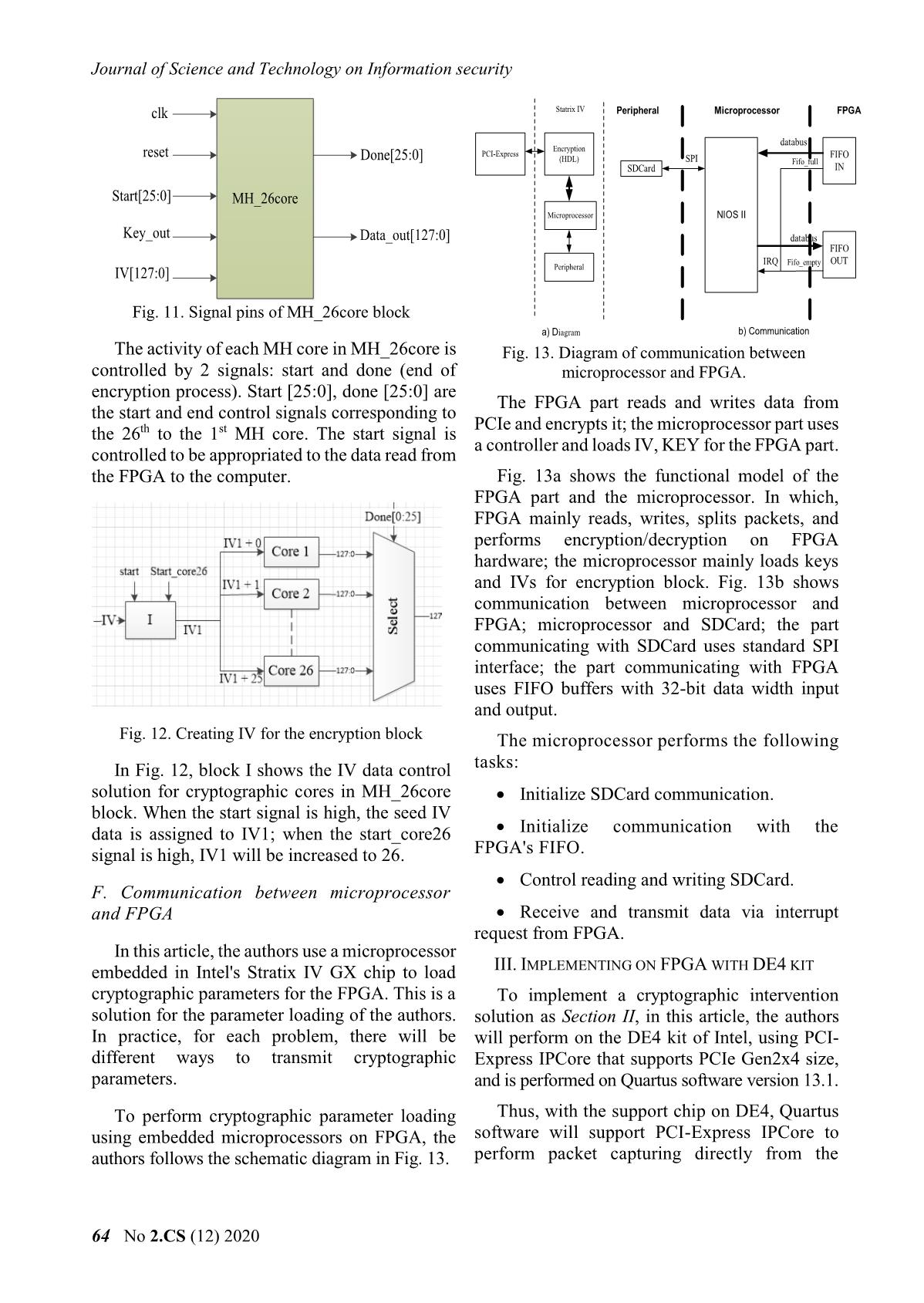
Trang 6
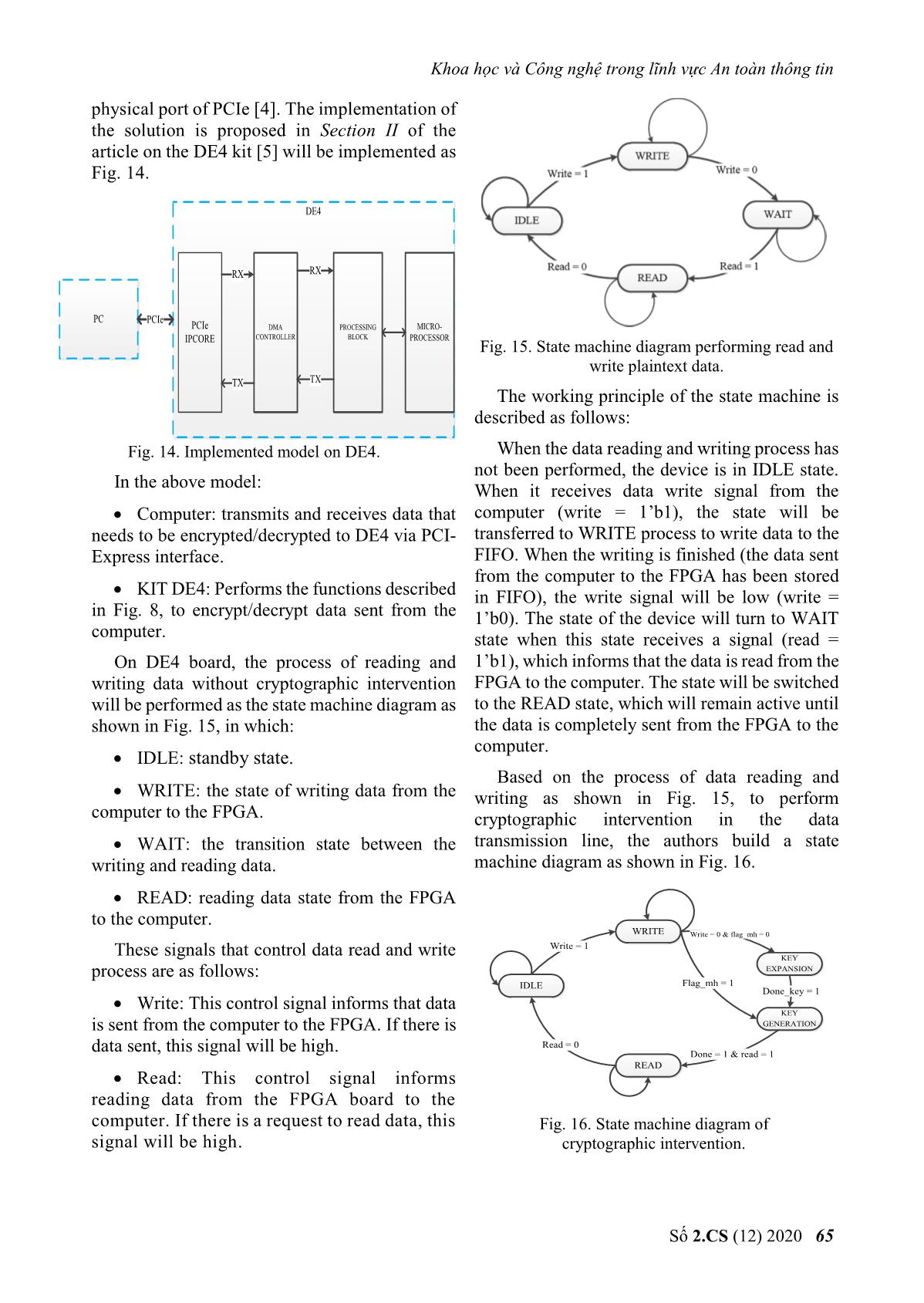
Trang 7
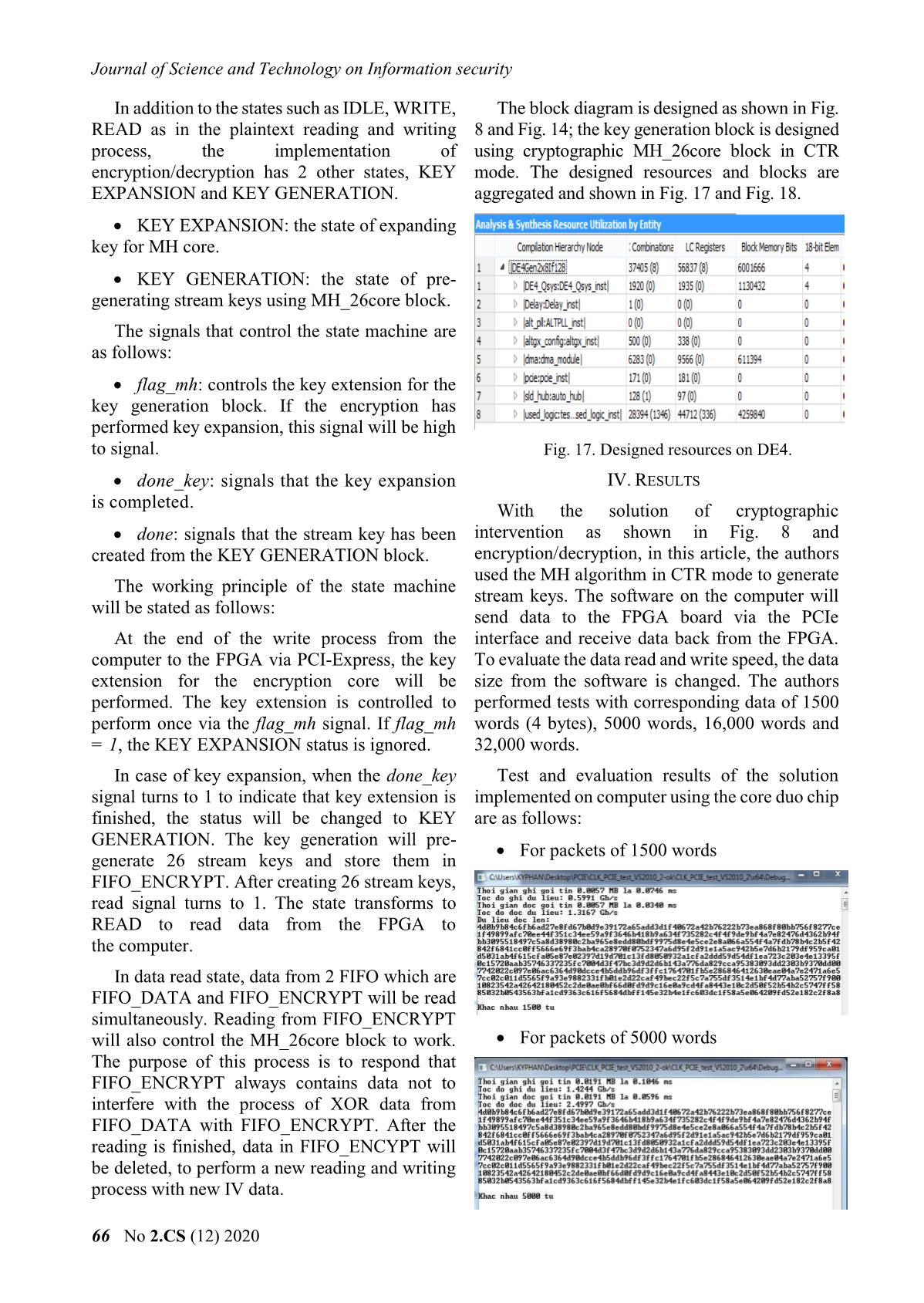
Trang 8
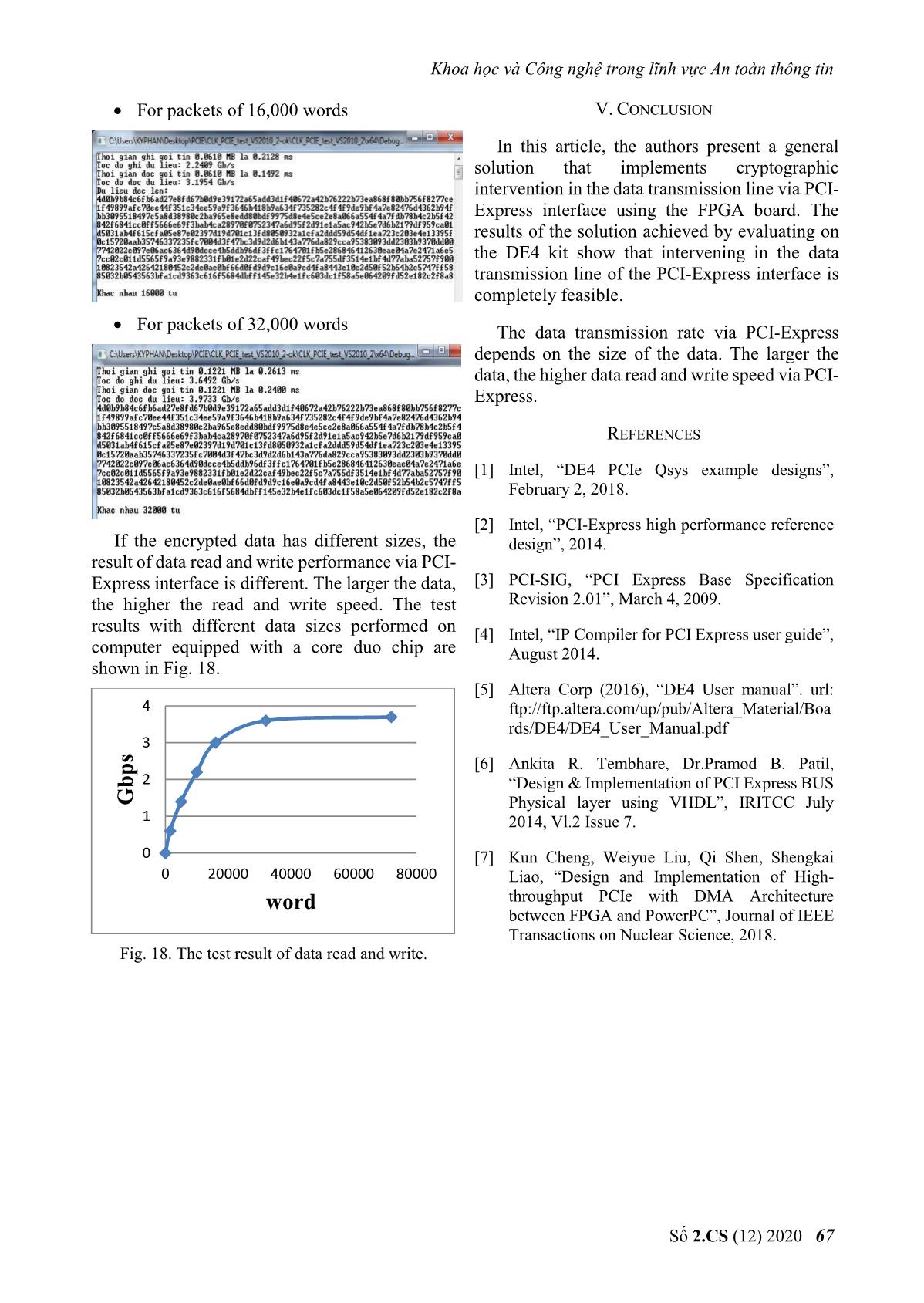
Trang 9

Trang 10
Tóm tắt nội dung tài liệu: Solution for Cryptographic Intervention in PCI-Express Data Transmission on FPGA Board
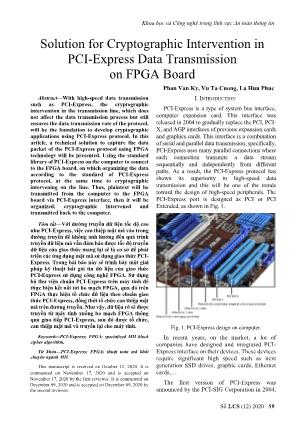
Khoa học và Công nghệ trong lĩnh vực An toàn thông tin Số 2.CS (12) 2020 59 Solution for Cryptographic Intervention in PCI-Express Data Transmission on FPGA Board Phan Van Ky, Vu Ta Cuong, La Huu Phuc Abstract—With high-speed data transmission such as PCI-Express, the cryptographic intervention in the transmission line, which does not affect the data transmission process but still ensures the data transmission rate of the protocol, will be the foundation to develop cryptographic applications using PCI-Express protocol. In this article, a technical solution to capture the data packet of the PCI-Express protocol using FPGA technology will be presented. Using the standard library of PCI-Express on the computer to connect to the FPGA board, on which organizing the data according to the standard of PCI-Express protocol, at the same time to cryptographic intervening on the line. Thus, plaintext will be transmitted from the computer to the FPGA board via PCI-Express interface, then it will be organized, cryptographic intervened and transmitted back to the computer. Tóm tắt—Với đường truyền dữ liệu tốc độ cao như PCI-Express, việc can thiệp mật mã vào trong đường truyền để không ảnh hưởng đến quá trình truyền dữ liệu mà vẫn đảm bảo được tốc độ truyền dữ liệu của giao thức mang lại sẽ là cơ sở để phát triển các ứng dụng mật mã sử dụng giao thức PCI- Express. Trong bài báo này sẽ trình bày một giải pháp kỹ thuật bắt gói tin dữ liệu của giao thức PCI-Express sử dụng công nghệ FPGA. Sử dụng bộ thư viện chuẩn PCI-Express trên máy tính để thực hiện kết nối tới bo mạch FPGA, qua đó trên FPGA thực hiện tổ chức dữ liệu theo chuẩn giao thức PCI-Express, đồng thời tổ chức can thiệp mật mã trên đường truyền. Như vậy, dữ liệu rõ sẽ được truyền từ máy tính xuống bo mạch FPGA thông qua giao tiếp PCI-Express, sau đó được tổ chức, can thiệp mật mã và truyền lại cho máy tính. Keyword—PCI-Express; FPGA; specialized MH block cipher algorithm. Từ khóa—PCI-Express; FPGA; thuật toán mã khối chuyên ngành MH. This manuscript is received on October 12, 2020. It is commented on November 17, 2020 and is accepted on November 17, 2020 by the first reviewer. It is commented on December 09, 2020 and is accepted on December 09, 2020 by the second reviewer. I. INTRODUCTION PCI-Express is a type of system bus interface, computer expansion card. This interface was released in 2004 to gradually replace the PCI, PCI- X, and AGP interfaces of previous expansion cards and graphics cards. This interface is a combination of serial and parallel data transmission, specifically, PCI-Express uses many parallel connections where each connection transmits a data stream sequentially and independently from different paths. As a result, the PCI-Express protocol has shown its superiority in high-speed data transmission and this will be one of the trends toward the design of high-speed peripherals. The PCI-Express port is designed as PCI or PCI Extended, as shown in Fig. 1. Fig. 1. PCI-Express design on computer. In recent years, on the market, a lot of companies have designed and integrated PCI- Express interface on their devices. These devices require significant high speed such as next generation SSD drives, graphic cards, Ethernet cards, The first version of PCI-Express was announced by the PCI-SIG Corporation in 2004, Journal of Science and Technology on Information security 60 No 2.CS (12) 2020 called version 1.0. Along with the development of science and technology, the PCI-SIG Corporation has continued researches and development of the PCI-Express protocol to increase data transmission speed. Until now, this group has announced 5 different versions of the protocol which are shown in Fig. 2. Fig. 2. Versions of PCI-Express. For version 2.0, PCI-SIG has been improved to increase the speed from 2.5 GT/s of version 1.0 to 5.0 GT/s. Versions 1.0 and 2.0 use the same encoding mechanism 8b/10b, version 2.0 is still compatible with version 1.0 in terms of hardware ports, thus an old card can still work on a new machine with version 2.0. Version 3.0 uses encoding mechanism 128b/130b, which will have lower loss than version 1.0 and 2.0. Nowadays, in addition to increasing the data rate by changing to the higher versions, PCI-SIG has also been designed to increase the speed of data transfer via PCI-Express for each of its versions by expanding the number of lanes of transmitting data. Each version is designed to support x1 (corresponding to the number of lanes of transmitting data via PCI-Express), x4, x8, x16 and even a version designed up to x32. The maximum bandwidth of the PCI-Express versions is shown in Fig. 3. Fig. 3. Bandwidth of PCI-Express. With the advantage of high-speed data transmission, the PCI-Express protocol has been put into their devices by many companies and developers, such as next generation SSD hard drive, Ethernet network card, HSM device, Along with the advancement of technology, the FPGA developers have applied the PCI- Express protocol to their boards, alo developed and integrated PCI-Express IPCore on the software of the company. The advantage of the high-speed transmission of the PCI-Express protocol, and of the ability to process data in parallel of the FPGA allow users to create specialized equipment for high-speed data processing, especially cryptographic devices. In this article, the authors propose a solution that directly reads and writes the PCI-Express data packet, organizes packing data frame according to the PCI-Express standard, and intervening in encryption/decryption by HDL hardware language. The content of the article includes 4 sections: Section I - Introduction, Section II - Solution, Section III - the implementation on DE4 FPGA kit of Intel, Section IV ... pted/decrypted. This data will be stored in the memory on the FPGA. And during writing data to the FPGA, the key generation block will take the IV and the current key to generate the stream keys and store it in a buffer, in order to require the data transmission line of the PCI-Express. When there is a reading signal, the encrypted/decrypted data will be sent to the computer. E. Design of key generation block on FPGA In this article, the authors use the specialized MH cipher algorithm to perform the cryptographic intervention in the transmission line of PCI-Express. Thus, on the FPGA board, MH cipher algorithm is designed as follows and in Fig. 9: Data input: 128 bits Key: 256 bits. Working clock: 125 MHz, according to the working frequency of PCI-Express IPCore. Data output: 128 bits. MH Key Data_in[127:0] start Data_out[127:0] Done Fig. 9. Signal pin diagram of MH core. Design of the Key generation block, depends on the problem and different modes. In this article, the authors mainly focus on the problem of examining the feasibility of the cryptographic intervention in the data transmission line of PCI-Express. Therefore, the authors design the Key generation block in CTR mode and use many MH cores to speed up the encryption/decryption. The solution for Key generation block is shown in Fig. 10. MH_26core FIFO_ENCRYPT Key extension IV VXL KEY Key_out 127:0 127:0 127:0 Fig. 10. Key generation model The microprocessor will give the encryption core 128-bit IV and 512-bit key. When the FPGA receives the key and IV data from the microprocessor, combined with the start signal, the key expansion for the MH encryption core will be performed. In the problem of this article, key expansion is performed only one time for the process of reading and writing data from the computer to the FPGA and vice versa. When the key expansion is done, MH core will encrypt the data in CTR mode. When there is an end signal of the core, the output data of MH will be stored in FIFO_ENCRYPT memory. The structure of MH-26Core block is shown in Fig. 11. The parameters of the block are as follows: Number of MH core: 26 cores. Working frequency: 125MHz. Encryption mode: CTR. Input/output: 128 bits. Journal of Science and Technology on Information security 64 No 2.CS (12) 2020 MH_26core clk reset Start[25:0] Key_out IV[127:0] Done[25:0] Data_out[127:0] Fig. 11. Signal pins of MH_26core block The activity of each MH core in MH_26core is controlled by 2 signals: start and done (end of encryption process). Start [25:0], done [25:0] are the start and end control signals corresponding to the 26th to the 1st MH core. The start signal is controlled to be appropriated to the data read from the FPGA to the computer. Fig. 12. Creating IV for the encryption block In Fig. 12, block I shows the IV data control solution for cryptographic cores in MH_26core block. When the start signal is high, the seed IV data is assigned to IV1; when the start_core26 signal is high, IV1 will be increased to 26. F. Communication between microprocessor and FPGA In this article, the authors use a microprocessor embedded in Intel's Stratix IV GX chip to load cryptographic parameters for the FPGA. This is a solution for the parameter loading of the authors. In practice, for each problem, there will be different ways to transmit cryptographic parameters. To perform cryptographic parameter loading using embedded microprocessors on FPGA, the authors follows the schematic diagram in Fig. 13. PCI-Express Encryption (HDL) Microprocessor Peripheral Statrix IV NIOS II SPI SDCard FIFO IN FIFO OUT databus databus IRQ Fifo_full Fifo_empty MicroprocessorPeripheral FPGA a) Diagram b) Communication Fig. 13. Diagram of communication between microprocessor and FPGA. The FPGA part reads and writes data from PCIe and encrypts it; the microprocessor part uses a controller and loads IV, KEY for the FPGA part. Fig. 13a shows the functional model of the FPGA part and the microprocessor. In which, FPGA mainly reads, writes, splits packets, and performs encryption/decryption on FPGA hardware; the microprocessor mainly loads keys and IVs for encryption block. Fig. 13b shows communication between microprocessor and FPGA; microprocessor and SDCard; the part communicating with SDCard uses standard SPI interface; the part communicating with FPGA uses FIFO buffers with 32-bit data width input and output. The microprocessor performs the following tasks: Initialize SDCard communication. Initialize communication with the FPGA's FIFO. Control reading and writing SDCard. Receive and transmit data via interrupt request from FPGA. III. IMPLEMENTING ON FPGA WITH DE4 KIT To implement a cryptographic intervention solution as Section II, in this article, the authors will perform on the DE4 kit of Intel, using PCI- Express IPCore that supports PCIe Gen2x4 size, and is performed on Quartus software version 13.1. Thus, with the support chip on DE4, Quartus software will support PCI-Express IPCore to perform packet capturing directly from the Khoa học và Công nghệ trong lĩnh vực An toàn thông tin Số 2.CS (12) 2020 65 physical port of PCIe [4]. The implementation of the solution is proposed in Section II of the article on the DE4 kit [5] will be implemented as Fig. 14. DE4 PC PCIe PCIe IPCORE DMA CONTROLLER RX TX PROCESSING BLOCK RX TX MICRO- PROCESSOR Fig. 14. Implemented model on DE4. In the above model: Computer: transmits and receives data that needs to be encrypted/decrypted to DE4 via PCI- Express interface. KIT DE4: Performs the functions described in Fig. 8, to encrypt/decrypt data sent from the computer. On DE4 board, the process of reading and writing data without cryptographic intervention will be performed as the state machine diagram as shown in Fig. 15, in which: IDLE: standby state. WRITE: the state of writing data from the computer to the FPGA. WAIT: the transition state between the writing and reading data. READ: reading data state from the FPGA to the computer. These signals that control data read and write process are as follows: Write: This control signal informs that data is sent from the computer to the FPGA. If there is data sent, this signal will be high. Read: This control signal informs reading data from the FPGA board to the computer. If there is a request to read data, this signal will be high. Fig. 15. State machine diagram performing read and write plaintext data. The working principle of the state machine is described as follows: When the data reading and writing process has not been performed, the device is in IDLE state. When it receives data write signal from the computer (write = 1’b1), the state will be transferred to WRITE process to write data to the FIFO. When the writing is finished (the data sent from the computer to the FPGA has been stored in FIFO), the write signal will be low (write = 1’b0). The state of the device will turn to WAIT state when this state receives a signal (read = 1’b1), which informs that the data is read from the FPGA to the computer. The state will be switched to the READ state, which will remain active until the data is completely sent from the FPGA to the computer. Based on the process of data reading and writing as shown in Fig. 15, to perform cryptographic intervention in the data transmission line, the authors build a state machine diagram as shown in Fig. 16. IDLE WRITE KEY EXPANSION READ KEY GENERATION Write = 1 Write = 0 & flag_mh = 0 Done_key = 1 Done = 1 & read = 1 Read = 0 Flag_mh = 1 Fig. 16. State machine diagram of cryptographic intervention. Journal of Science and Technology on Information security 66 No 2.CS (12) 2020 In addition to the states such as IDLE, WRITE, READ as in the plaintext reading and writing process, the implementation of encryption/decryption has 2 other states, KEY EXPANSION and KEY GENERATION. KEY EXPANSION: the state of expanding key for MH core. KEY GENERATION: the state of pre- generating stream keys using MH_26core block. The signals that control the state machine are as follows: flag_mh: controls the key extension for the key generation block. If the encryption has performed key expansion, this signal will be high to signal. done_key: signals that the key expansion is completed. done: signals that the stream key has been created from the KEY GENERATION block. The working principle of the state machine will be stated as follows: At the end of the write process from the computer to the FPGA via PCI-Express, the key extension for the encryption core will be performed. The key extension is controlled to perform once via the flag_mh signal. If flag_mh = 1, the KEY EXPANSION status is ignored. In case of key expansion, when the done_key signal turns to 1 to indicate that key extension is finished, the status will be changed to KEY GENERATION. The key generation will pre- generate 26 stream keys and store them in FIFO_ENCRYPT. After creating 26 stream keys, read signal turns to 1. The state transforms to READ to read data from the FPGA to the computer. In data read state, data from 2 FIFO which are FIFO_DATA and FIFO_ENCRYPT will be read simultaneously. Reading from FIFO_ENCRYPT will also control the MH_26core block to work. The purpose of this process is to respond that FIFO_ENCRYPT always contains data not to interfere with the process of XOR data from FIFO_DATA with FIFO_ENCRYPT. After the reading is finished, data in FIFO_ENCYPT will be deleted, to perform a new reading and writing process with new IV data. The block diagram is designed as shown in Fig. 8 and Fig. 14; the key generation block is designed using cryptographic MH_26core block in CTR mode. The designed resources and blocks are aggregated and shown in Fig. 17 and Fig. 18. Fig. 17. Designed resources on DE4. IV. RESULTS With the solution of cryptographic intervention as shown in Fig. 8 and encryption/decryption, in this article, the authors used the MH algorithm in CTR mode to generate stream keys. The software on the computer will send data to the FPGA board via the PCIe interface and receive data back from the FPGA. To evaluate the data read and write speed, the data size from the software is changed. The authors performed tests with corresponding data of 1500 words (4 bytes), 5000 words, 16,000 words and 32,000 words. Test and evaluation results of the solution implemented on computer using the core duo chip are as follows: For packets of 1500 words For packets of 5000 words Khoa học và Công nghệ trong lĩnh vực An toàn thông tin Số 2.CS (12) 2020 67 For packets of 16,000 words For packets of 32,000 words If the encrypted data has different sizes, the result of data read and write performance via PCI- Express interface is different. The larger the data, the higher the read and write speed. The test results with different data sizes performed on computer equipped with a core duo chip are shown in Fig. 18. Fig. 18. The test result of data read and write. V. CONCLUSION In this article, the authors present a general solution that implements cryptographic intervention in the data transmission line via PCI- Express interface using the FPGA board. The results of the solution achieved by evaluating on the DE4 kit show that intervening in the data transmission line of the PCI-Express interface is completely feasible. The data transmission rate via PCI-Express depends on the size of the data. The larger the data, the higher data read and write speed via PCI- Express. REFERENCES [1] Intel, “DE4 PCIe Qsys example designs”, February 2, 2018. [2] Intel, “PCI-Express high performance reference design”, 2014. [3] PCI-SIG, “PCI Express Base Specification Revision 2.01”, March 4, 2009. [4] Intel, “IP Compiler for PCI Express user guide”, August 2014. [5] Altera Corp (2016), “DE4 User manual”. url: ftp://ftp.altera.com/up/pub/Altera_Material/Boa rds/DE4/DE4_User_Manual.pdf [6] Ankita R. Tembhare, Dr.Pramod B. Patil, “Design & Implementation of PCI Express BUS Physical layer using VHDL”, IRITCC July 2014, Vl.2 Issue 7. [7] Kun Cheng, Weiyue Liu, Qi Shen, Shengkai Liao, “Design and Implementation of High- throughput PCIe with DMA Architecture between FPGA and PowerPC”, Journal of IEEE Transactions on Nuclear Science, 2018. 0 1 2 3 4 0 20000 40000 60000 80000 G b p s word Journal of Science and Technology on Information security 68 No 2.CS (12) 2020 ABOUT THE AUTHOR Phan Van Ky Workplace: Institute of Cryptographic Science and Technology Email: pvk.hvktqs@gmail.com Education: Received bachelor’s degree in 2013, received master’s degree in 2017, in Saint Petersburg Electronical University. Current research field: integrated circuit technology, FPGA. Vu Ta Cuong Workplace: Institute of Cryptographic Science and Technology Email: vutacuong109@gmail.com Education: Received bachelor's degree in 2011, master's degree in 2013, and PhD in 2016, in Radio Electronics, Kharkiv Aerospace University, Ukraine. Current research field: PKI Token, cryptographic engineering. La Huu Phuc Workplace: Institute of Cryptographic Science and Technology Email: phucpvkt@hotmail.com Education: Received bachelor's degree in 1998, master’s degree in 2002, and PhD in 2015 in Electronic engineering. Current research field: Designing and producing security device, specialized cipher machine.
File đính kèm:
 solution_for_cryptographic_intervention_in_pci_express_data.pdf
solution_for_cryptographic_intervention_in_pci_express_data.pdf

